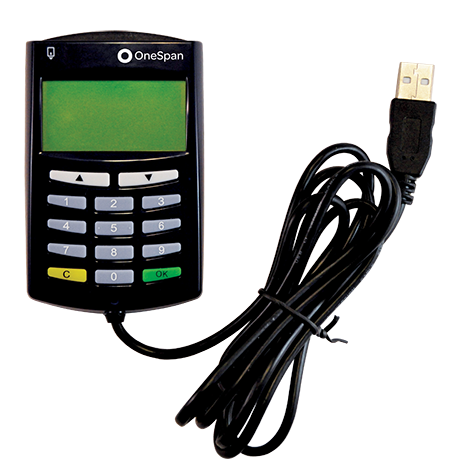HIGHLIGHTS
Digipass 920 offers high level security to banks to protect high value transactions. Its ‘What You See is What You Sign’ feature and reader signature ensures security is guaranteed at both ends of the transaction.
Increased identity and data theft, man-in-the-middle attacks, unauthorized access to confidential data demonstrate the growing need for secure solutions. OneSpan has a solid reputation in helping financial institutions in securing transactions online through two-factor authentication. With Digipass 920, OneSpan offers a solution for environments requiring high level security.
Digipass 920 is perfectly suited for environments with high security requirements such as corporate banking environments. It offers PKI/digital signatures capability and offers a solution for high value transactions in corporate environments, Internet banking, e-commerce and e-government environments.
Digipass 920 is OneSpan’s USB connected card reader. It has a sophisticated user interface with a keypad with 14 keys and a full dot matrix display. Digipass 920 operates as a PIN pad reader offering secure PIN entry and “What You See Is What You Sign” (WYSIWYS) functionality. Digipass 920 can also generate its own signature next to the card-based signature. This way banks are able to verify whether the digital signature was made by a genuine reader, rather than a misused transparent reader. Hence, Digipass 920 offers even a higher level of security and verification mechanisms to the bank especially when dealing with high value transactions.
See it before you sign it
Digipass 920 has a full dot matrix display allowing extended data field validation on the Digipass screen. The large screen sets a new standard for e-signature offering high transaction security thanks to the “what you see is what you sign” (WYSIWYS) capability. With WYSIWYS, the user will validate the key data on his Digipass 920 display before he signs the transaction.
Reader signature
The bank which issues Digipass 920 to its customers can verify that a transaction is approved and signed by his customer with a genuine card reader. When that same transaction is signed by an unauthorized reader it would have been rejected. As a result Digipass 920 offers additional security guarantees on both sides of the transaction. The end-user can trust the data he digitally signed since they were displayed in the secure environment of a trusted reader.
The bank who issued the card reader can check that his genuine “WYSIWYS” reader has been used during the transaction. This verification can also be undertaken by any third party linked to the bank who issues the reader without compromising the reader security or having to share any secure key stored into the reader.
Protecting smart card PIN
Today, still a large number of applications continue to use smart cards that are inadequately protected with static PINs. Online applications are exposed to Trojans or key-loggers intercepting a static PIN/password entry on the PC keyboard for smart card-based online transactions fraud. From a security point of view, PIN entry on a keyboard offers inadequate security for a PC connected to the Internet. Digipass 920 provides the secure environment: the PIN is directly onto the reader and not on the computer keyboard. As a result the PIN can never be intercepted via the PC. Similarly, smart card PIN codes can securely be altered on the Digipass 920 keypad.

Easy deployment, installation and use
Digipass 920 uses a standard driver compliant with all popular operating systems such as Windows, Linux and MacOS. Leveraging the available CCID driver, Digipass 920 does not require the installation of a separate driver on most of the popular PC platforms. The reader is not personalized and as a result can randomly be distributed to customers without compromising their security and benefitting deployment to large customer bases.
Firmware update
Digipass 920 firmware and applications can be updated by the bank which issues the card reader at any time even when Digipass 920 has already been issued to the enduser, making use of proven and standard cryptographic mechanisms.
SPECIFICATIONS
User interface
- 102 * 46 full dot matrix display
- Up to 6 lines, 120 characters
Smart Card interfac
- 8 contacts – Iso location
- Frequency up to 4 Mhz
- Supports ISO 7816 Class A and B smart cards (5V, 3V)
- 200,000 smart card insertions
- Embossed smart card supported
Size
97 * 61,7 * 11 mm
Weight
91 g
Keypad
Tactile keypad with silicon rubber key printed with an epoxy layer. Resistant to over 100,000 rubbings. 10 numeric keys and 4 function keys
Power supply
USB connection
Cable
1,5 m long USB cable with type A connector
Operating systems
Windows 7, Vista, XP, Windows server 2003 and 2008, Linux, Mac OS 10.5 and above
Standards
- ISO 7816
- USB 2.0 Full speed
- PC/SC 2.01
- CCID
- EMV level 1
- Belgian eID card
- Connected EMV CAP
Logo
Bank’s logo can be printed on the reader. Color of the casing can also be customized
COMPLIANCE
Short storage temperature
-10 °C to 50 °C;
90 % RH non condensing
- IEC 60068-2-78 (Damp heat)
- IEC 60068-2-1 (Cold)
Operating temperature
0 °C to 45 °C;
85 % RH non condensing
- IEC 60068-2-78 (Damp heat)
- IEC 60068-2-1 (Cold)
Tampering
Tamper evident
- ISO 13491-1
Vibration
10 to 75 Hz; 10 m/s2
- IEC 60068-2-6
Drop
1 meter
- IEC 60068-2-31
Emission
- EN 55022
Immunity
4 kV contact discharges;
8 kV air discharges;
3 V/m from 80 to 1000 MHz
- EN 61000-4-2 and
- EN 61000-4-3
Safety and environmental Compliance to European directives (CE marking)
- 2004/108/EC (EMC directives)
- 2002/95/EC (RoHS directive)
- 2002/96/EC (WEEE directive)